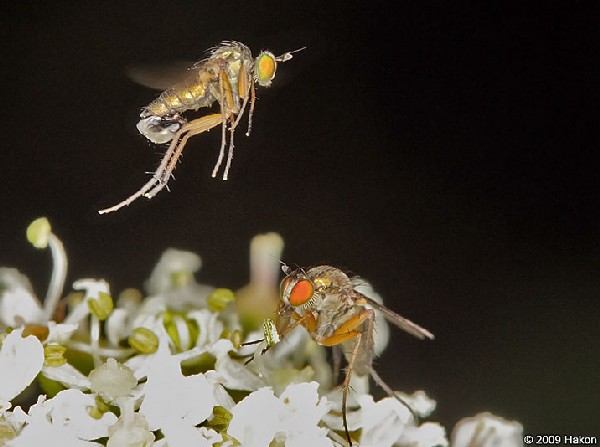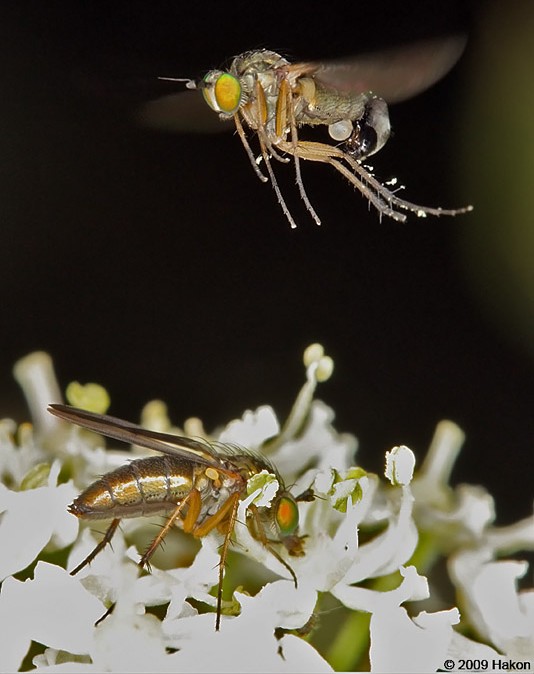| The observations of the behaviour described here were made in a 3-4 day period at the end of July 2009. Two days in a row I noticed small flies hovering over almost every umbelliferous flower in my neighbourhood, both small ones close to the ground, and large ones, in gardens and in the woods. After the first two days the activity diminished and later no more flies were seen. | |
 | |
The male fly hovered 3-10 cm above the flower, constantly changing direction and altitude. Its movements almost resembled a dance. Sometimes it would concentrate hovering for a while over a female (which seemed oblivious to the presence of the male). Most of the time the males were hovering but occasionally they would take breaks resting on the flower or proximate vegetation. Often in the higher parts. As mentioned, the females seemed oblivious to the presence of a male and were constantly foraging on the flowers. There's no way I can tell if the female gave the male a 'go' or if it was the male's orientation to the female that made the male plunge in and seemingly attack the female. | |
| Most attempts seemed to be unsuccessful as the male was quickly thrown off, and the female continued her foraging. I do not know if these instances resulted in successful fertilization. | |
| At other times the male hovered over the female more concentrated and he took more time to produce a package of sperm which he held ready for quite some time before diving, and copula was achieved. I could not observe them beyond this point as they flew away from the flower in copula and disappeared into the nearby vegetation. | |
| On flowers with several males and females there seemed to be no organisation in which male courted which female. However, males would chase each other if they came too close. | |
| I estimate that there were 2-4 females and equal number of males on an umbel measuring 20-30 cm in diameter, the number of flies being relative to the umbel's size. Small ones, for example 5 cm in diameter, usually had one of each sex. | |
| It seemed that weather or time of day did not play any part in courtship. Of course, I cannot say whether or not the actual successful mating was influenced by such. My observations of matings were made in the evening with light rain. | |
 | |
Many thanks to Paul Beuk for encouragement and editing, and to Igor Grichanov for species identification. | |
| January 7th, 2010 Hakon Haraldseide Norway |
 |
||
|
||
 Users Online
Forum Threads
Newest Threads
· Unknown Stratiomyida...· Milichiidae?->Chloro... · Heleomyzidae ? · Ceratopogonidae (Ton... · Bibionidae: Bibio re... Hottest Threads
No Threads created
Theme Switcher
Last Seen Users
Latest Photo Additions
|
Mating behaviour and courtship in Hercostomus germanus
Comments
Post Comment
Please Login to Post a Comment.
Ratings
Rating is available to Members only.
Please login or register to vote. No Ratings have been Posted.
| Date and time
Login
Temporary email?
Due to fact this site has functionality making use of your email address, any registration using a temporary email address will be rejected.
Paul Donate
Latest Articles
· Voltinism in Chaoborus
· Vitaliy Nikolaevich ... · Mating behaviour and... · Oviposition into the... · African Invertebrates Syrph the Net
License Agreement - Click to Download Public files of Syrph the Net can be downloaded HERE Last updated: 25.08.2011 Shoutbox
You must login to post a message. 17.08.23 15:23 Aneomochtherus
17.08.23 13:54 Tony, I HAD a blank in the file name. Sorry!
17.08.23 13:44 Tony, thanks! I tried it (see "Cylindromyia"
 but don't see the image in the post. but don't see the image in the post.17.08.23 11:37 pjt - just send the post and attached image. Do not preview thread, as this will lose the link to the image,
16.08.23 08:37 Tried to attach an image to a forum post. jpg, 32kB, 72dpi, no blanks, ... File name is correctly displayed, but when I click "Preview Thread" it just vanishes. Help!
23.02.23 21:29 Has anyone used the Leica DM500, any comments.
27.12.22 21:10 Thanks, Jan Willem! Much appreciated.
 19.12.22 11:33 Thanks Paul for your work on keeping this forum available!
Just made a donation via PayPal.
09.10.22 17:07 Yes, dipterologists from far abroad, please buy your copy at veldshop.
Stamps will be expensive, but he, the book is unreasonably cheap
 07.10.22 11:55 Can any1 help out with a pdf copy of
1941 Hammer. Vidensk. Meddel. Dansk Naturhist. Foren. 105;
thank you
|
|
images in Diptera Gallery and Forum of their respective owners Powered by PHP-Fusion copyright © 2002 - 2025 by Nick Jones. Released as free software without warranties under GNU Affero GPL v3. SimpleAsThat |
||
| Render time: 0.02 seconds | 199,958,975 unique visits | ||










